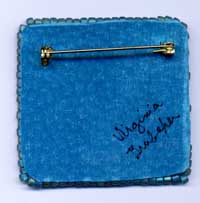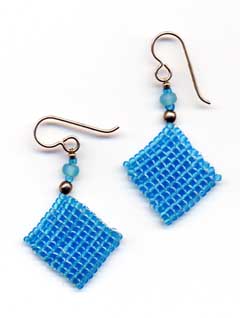|
Practical Beading Projects from Beadwork SamplesHere are some beading projects so you can turn your beaded bits into finished works if you choose. 1. Brooches
To make a brooch, glue your piece to a fairly thin backing. I usually use ultrasuede or suede. After the glue dries, trim the suede to the size of the beadwork. Glue a pin finding near the top edge of your piece. Let the glue dry. 
Cut out a second piece of suede, approximately the size of the first. Mark the two locations where the pin finding rise to meet the pin. Cut a slit, a circle, or a small square at each of those spots. I try out this liner layer in place and make sure I have removed just enough suede so that it will lie flat. Then I glue it in place. Special note for loom-woven pieces. When I am going to mount a small loomed piece for a brooch, I wrap the warp ends in a very thin strip of glued fabric. To do this, I pull the outer warps inward a bit, so my secret won't show on the edge. I glue the strip under the smoothed-out warp threads, then fold the ends of the strip back over the warps, creating a thin warp sandwich. I do this to both ends, with the warps pulled away from the beadwork, so I don't get glue on the beadwork at this point. I work on a sheet of waxed paper so that I don't accidentally glue the warp to something else. Whan the glue is dry, I trim any warp ends that extend beyond my fabric, fold the ends in place on the back of the work, and glue them down. It's a pretty easy way for me to deal with the warp on a piece that is going to be glued anyway. 2. Earring Dangles
Earrings are always popular and useful beading projects. Here I have used small samples that I made when I was learning square stitch as earring dangles. If you have small shapes that might do well on earrings, add a loop of seed beads to the top corner of your beadwork. Go back through the beads as many times as you can, then finish off the thread in the body of your beaded shape. Hang the piece from an ear wire, and you're done! Or do as I have done in the picture, assembling the square, some beads at the top, and the ear wire, all connected with thread. If you want to make small samples of a couple of stitches, consider making two in different stitches but the same size and color. Or just pick two samples that you think go well together. There is no law that earrings have to be identical. . . . 3. Necklace DanglesJust as you made earring dangles, you can take unmatched swatches and use them as dangles from a chain or other necklace. Consider spacing a number of them in the front of a necklace. Consider hanging them in front of disks of shell, metal, or acrylic. 4. BraceletsYou can sew suitably sized bits together to make a bracelet, perhaps putting squares on the diagonal and overlapping them at the points. You can also use the bracelet itself as the swatch, as in this color-blending experiment: 
Other great bracelet beading projects (that are really learning assignments in disguise) would be simple flat bracelets, maybe in peyote or herringbone, that do an exquisitely slow color gradation. 5. Decorate a BoxConsider painting a small box, maybe a tin from mints, and gluing a single piece to the middle of the lid. If it looks lonely there, consider gluing strands of beads around it, or just a row or two near the edge of the box. You can see a great example of the whole process of mounting beading on a mints tin on a page in the Bead Art section of the website. It's about creating bead art in the form of an embroidered drawing, which is then glued to the tin. You can see it here. About GluesI Use E600 for most of these glue-mounted applications in my beading projects. It is smelly to work with, but it had some real body so you can catch every bead in it if you pay a bit of attention to pressing things down into place. A great resource for glue is at
This to That.
When I am puzzled about what glue is suitable both for the glass beads and for the surface I'm gluing to, I go to This to That for glue advice. They are not sponsored by any glue manufacturer, but are just folks who use glues and are curious about them. Their main person is a theater prop master; ya gotta imagine there's a lot of glue used in that job!
Return from Practical Beading Projects to Free Beading Projects
|

